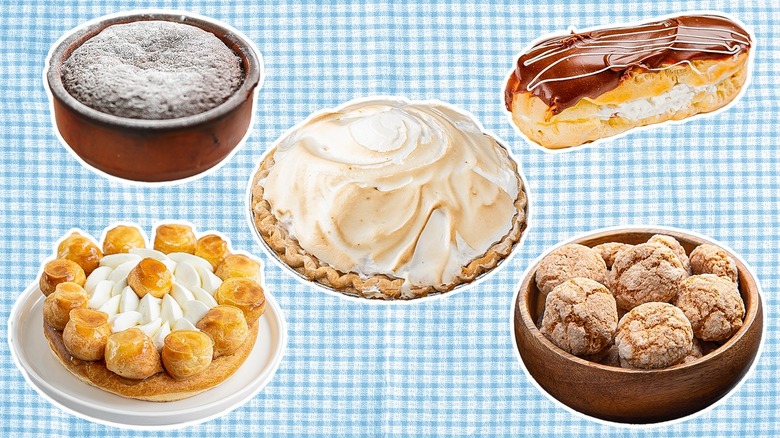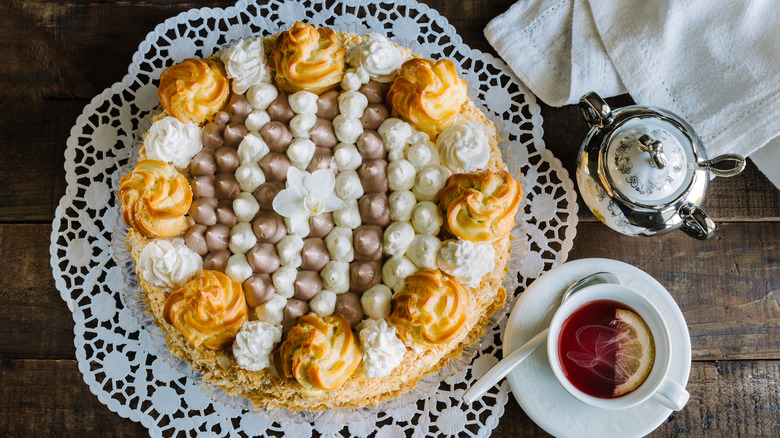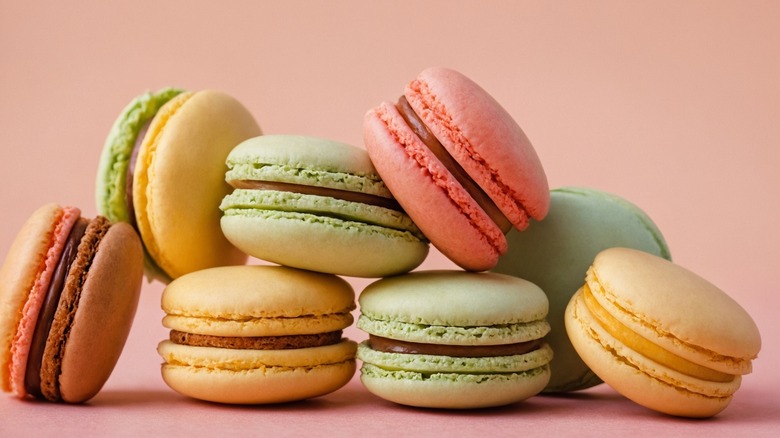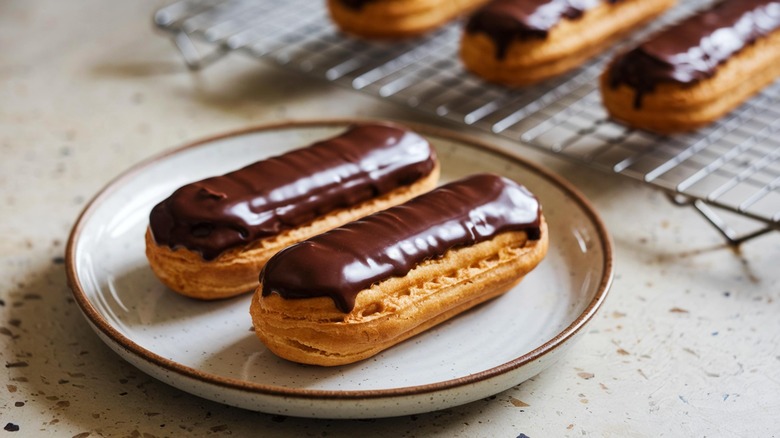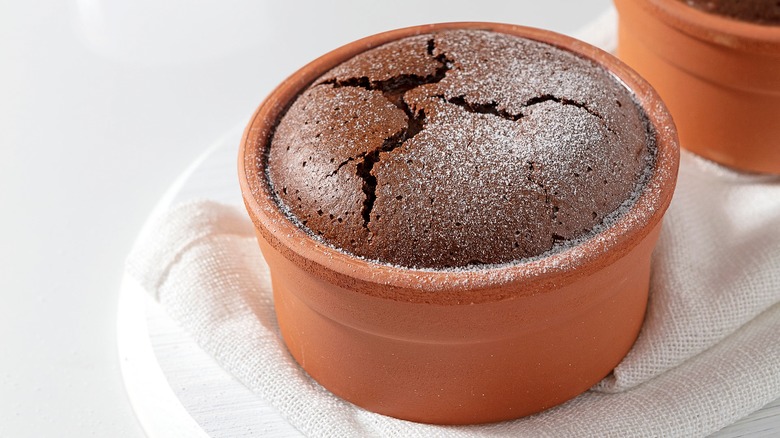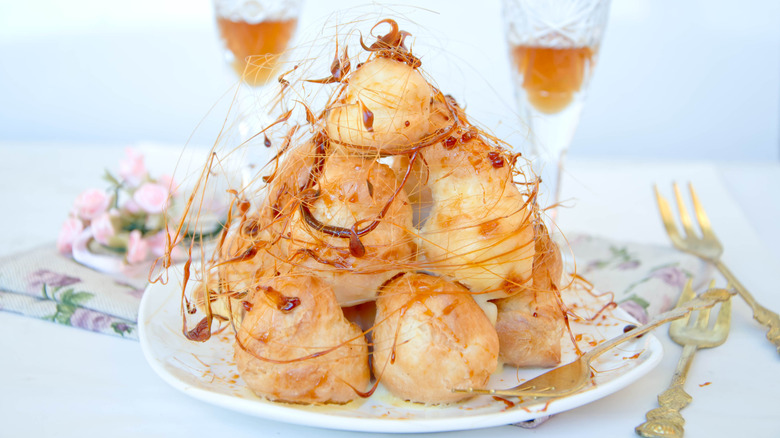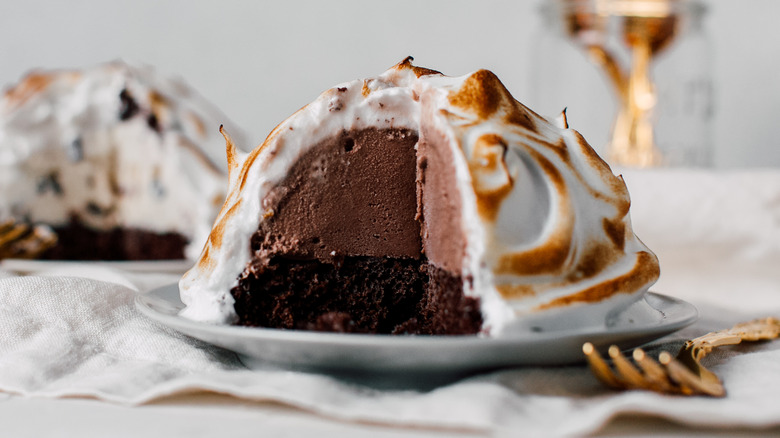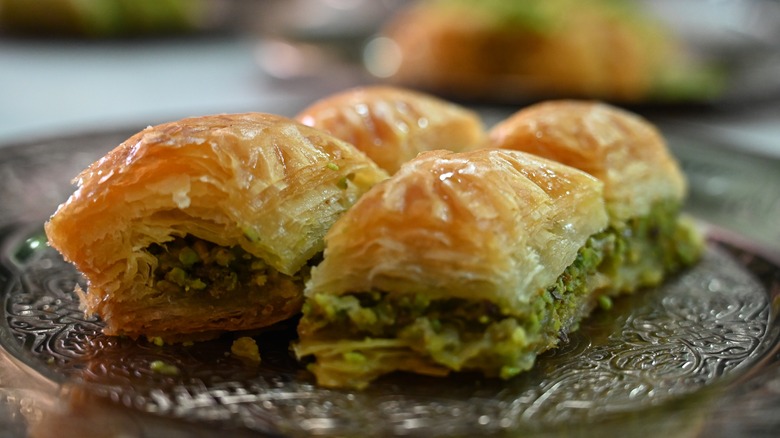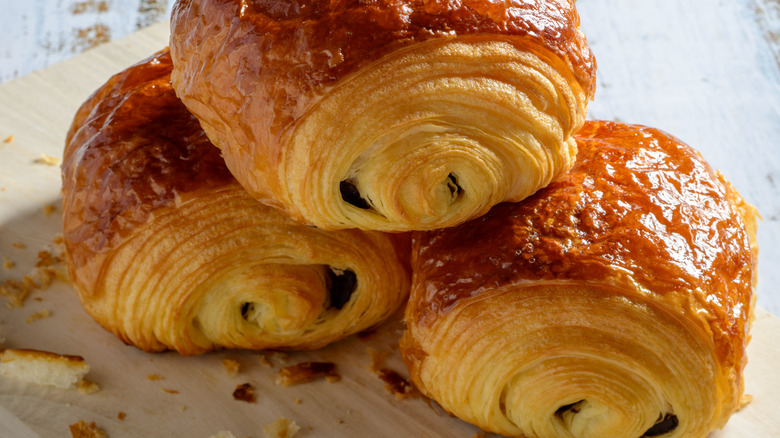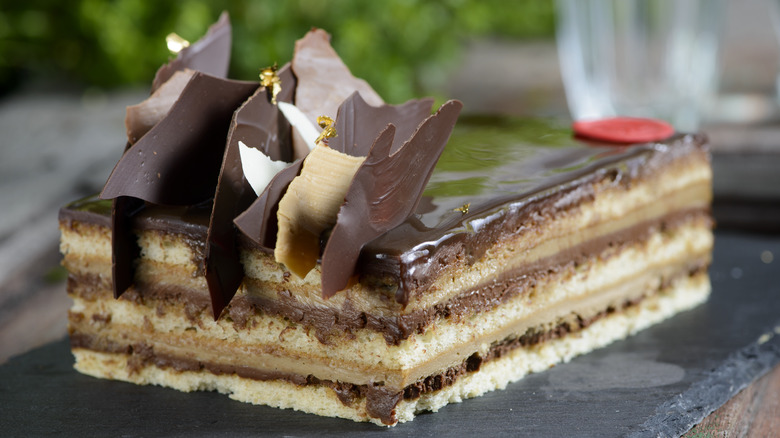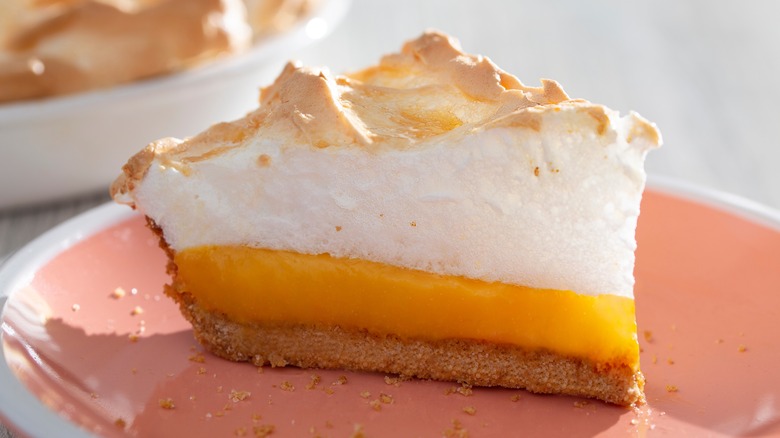The 11 Hardest Desserts To Make, According To Pastry Chefs
Pastry chefs are culinary scientists. Take chocolate soufflé, for example. It's a deceivingly simple dessert made with ingredients every baker should have on hand, like flour, milk, and eggs. At the same time, many consider it one of the hardest desserts in the world to make. Baking requires more precision than traditional cooking. After all, it's much easier to remedy an over-salted stew than it is to coax bread to rise when the measurements are off. And precise measurements aren't even the half of it — there are also meticulous whisking techniques to learn, delicate ingredients to handle, and strict time constraints to follow.
Even experienced pastry chefs pull deflated soufflés from the oven now and again. From éclairs to lemon meringue pie and more, some desserts have intimidating reputations. Without visionary pâtissiers like French chef Antoine Beauvilliers, who's credited with creating chocolate soufflé, or Pierre Hermé, "The Picasso of pastry," who redefined macarons, life would be a lot less sweet.
These chefs and other masters like them have gifted our palates with some of the tastiest desserts out there, but they're also some of the hardest to make, hands-down. This list of saccharine marvels may just make pastry chefs shake in their bones. To find out why, we consulted experts Heidi Ross, a private chef and culinary artist; Caroline Schiff, one of Food & Wine's best new chefs of 2022; and Sumaiya Bangee, a pastry chef and consultant.
Gateau Saint Honoré
This French delicacy belongs to an elite class of desserts. Named after a chapel dedicated to a legendary bishop, Gateau Saint Honoré is a complex gateau (a fluffy style of cake with ultra-creamy frosting) composed of puff pastry, choux pastry, fresh caramel, a special whipped cream called Chantilly, and crème Chiboust. Sophisticated is one way to describe it — hair-pulling is another. Along with puff pastries, which are notoriously time-consuming to make, choux pastry and crème Chiboust aren't cakewalks, either. If just one misses the mark, it ruins the entire dessert. That's five hours of nerve-wracking baking down the drain.
Fortunately, Sumaiya Bangee shared the secret ingredient for pulling it off: "Making puff pastry can be considered difficult to the untrained eye, but in my professional opinion, all it takes is patience. So much of creating the perfect pastry is patience." Ironically, timing is also of the essence. Each piece must be made individually, stored properly during the process, and completed within a time frame that doesn't compromise the ingredients. "I would say what makes this specific dessert hard is how many technical components it takes to get to the final results, so it truly is a harmony of everything going correctly," Bangee underscored. Along with traditional Gateau Saint Honoré, there are versions topped with fresh fruit, sweet drizzles, and ice cream.
Macarons
Who hasn't fallen under the spell of a bakery's macaron display? The array of colors is just a preview of the sweet experience that awaits. Macarons, not to be confused with macaroons, are meringue-based sandwich cookies. There are three varieties, depending on the style of meringue used: Italian, French, and Swiss. The cookies are made with four simple ingredients: almond flour, egg whites, confectioners' sugar, and food coloring. They also contain saccharine fillings like ganache, fruit jams, and buttercream. Making them is anything but simple, however, as meringues require a particular whisking technique.
Learning the proper technique is just one hurdle. To get that smooth, bakery-quality sheen on the cookie, you have to handle the flour with care. "For the macarons, it's not just figuring out the right timing/texture of the whip on the egg white, but the delicate folding in of the almond flour (which should be sifted carefully beforehand to ensure smooth texture)," said Heidi Ross.
French is the easiest and most common meringue, though it's the least sturdy of the three. Swiss meringue has a smoother, denser consistency but can be tricky for those who've never used a double boiler. Italian meringue is considered the best and most challenging. The key step that makes Italian meringue unique is that it uses cooked sugar syrup rather than granulated sugar (as the French style does) and has a more feathery, melt-in-your-mouth consistency. A rapid, meticulous whisking technique blends egg whites and hot sugar syrup into a stable, ready-to-eat cloud of sweetness.
Éclairs
Éclairs need no introduction. These custardy pastries hold the dual honor of being one of the world's most popular and hardest-to-make desserts. They're a classic cream-filled, icing-topped French invention that can only be made after conquering the infamous choux pastry (also called pâte à choux). Sumaiya Bangee said that trained pastry chefs should know choux pastry "like the back of their hand." Nevertheless, bakers may still stumble into pastry pitfalls, like using too much water or eggs or overworking the dough.
Chef Bangee added, "I personally love making choux pastry. Underbaked, it will lose its puff, and overbaked, it will be hard and crunchy, which isn't the texture of a choux pastry." Cooking the dough twice is a step you cannot miss when making choux. The first round of cooking takes place on the stovetop, and the second occurs in the oven, which produces a flaky, airy texture.
And that's just part of why éclairs can be tricky to perfect. "Éclairs are about getting the egg ratio right, as well as ensuring the bake on the choux pastry is correct," Bangee continued. Using a whisk or spatula may complicate things further, too. Using a spoon instead of a whisk will save you time making éclairs, as it's more efficient and reduces the chance that you overwork the dough, which should have a creamy yet fluffy consistency. Start small with this mini chocolate éclairs recipe, then work your way up.
Chocolate soufflé
Rich, melty, and iconic, chocolate soufflé has been intimidating pastry chefs for hundreds of years. Chocolate soufflé is a simple dessert that can be made with as few as two ingredients — or at least, it seems simple until you put on your apron and roll up your sleeves. Traditionally, soufflé is made from butter, eggs, chocolate, and sugar, and it's then dusted with powdered sugar.
The real reason soufflé is so difficult to make is that separating the egg whites without cross-contamination can prove challenging. Then, you have to whip them properly so that they absorb a sufficient amount of air, as aeration is key to the dessert's light, fluffy texture. If you fail to separate the egg whites, yolk remnants will prevent it from rising. You also have to be careful not to over-whip the eggs, which will make them less elastic and cause them to fall flat. According to Caroline Schiff, "It's very tricky to get the batter right for soufflés — enough stability without it becoming dense. Bake time is also hard to nail down, depending on your oven and the size of the soufflé. There's a small window between soupy and overdone/cakey."
Croquembouche
This next challenging dessert is a mouthful in more ways than one. Croquembouche, pronounced "kroh-kuhm-boosh" in English, is a doughy, caramel-dipped dessert composed of puff pastries stacked atop one another to form a tower of sweet, sugary excess. There are a number of reasons why this decorative French treat is considered one of the hardest desserts to make. If baking perfect choux balls isn't daunting enough, constructing a stable cone tower of them (and covering that tower in sugar threads) will be.
"A croquembouche starts with perfectly made cream puffs with usually a vanilla cream filling. The hard part comes in when you have to cook the caramel to the perfect color and dip all the cream puffs. It is imperative that the cream puffs are adequately dipped in the caramel to help build the structure," Sumaiya Bangee said. "As for the sugar threads, it's all about cooking the caramel to the perfect temperature so you're able to use a fork to pull the threads." Basically, croquembouche is another example of the intimidating world of French baking. Bangee did, however, offer some encouraging words. "A croquembouche is actually easier than one would think to make. With a few practice tries, it becomes a very fun and simple task."
Baked Alaska
Contrary to popular belief, the famous dessert Baked Alaska does not hail from the frozen tundra. Most likely French in origin, it was eventually dubbed "Alaska, Florida" to describe the dessert's contrasting temperatures. Composed of ice cream, cake, and toasted meringue, Baked Alaska traverses a delectable textural landscape. The challenging part is navigating your way toward the fiery grande finale. Consider this — you have to bake ice cream without it completely melting. What's more, the ice cream needs to be soft enough to mold but cold enough to retain its shape.
That doesn't even cover the overnight part of the process and those iconic spiked meringue peaks. "For the Baked Alaska, I do a Swiss meringue (heating the egg and sugar together before whipping) so it's somewhat stabilized," Heidi Ross shared, adding, "The liquor needs to be a higher proof to properly light ... 151 will work, or Everclear, but many states don't allow sales of alcohol that high. I also like to use a spirit called Spirytus — it's a food-grade grain alcohol with a very high proof." An oven or a blowtorch are likely the two best ways to toast meringue for Baked Alaska.
Baklava
A decadent product hailing from the Mediterranean, baklava is a layered dessert traditionally made with unleavened phyllo dough, sugar, and nuts. The one ingredient in baklava that causes trouble for pastry chefs is phyllo dough. It's paper-thin, extremely delicate, and likely to annoy on the first encounter. This papery dough is an 11th-century invention made of flour, water, vinegar, fat, and salt, and it's blended into a super-stretchy consistency that's then spread into thin, crispy sheets.
Phyllo dough is like puff pastry in that it can be used in both sweet and savory recipes, but that's about where the similarities end. One is meant to puff up while the other is not. Thawing frozen phyllo can also be tricky — it's brittle and can't sit at room temperature for more than two hours because it dries quickly. Baklava is a difficult dessert because, whether you're working with freshly made or pre-packaged phyllo, you have to cover it with a slightly damp towel as you work.
Don't let phyllo dough get you down, though. According to pastry connoisseur Sumaiya Bangee, "Some tricks are to cut your baklava after freezing slightly, as well as ensuring your honey syrup is nicely infused with fresh spices to kick the aromas up and to pour immediately after baklava comes out of the oven to ensure even soaking."
Pain au chocolat
In America, we say "chocolate croissant," but in France, this dessert is called pain au chocolat, and it's one of the most beloved pastries in the world. Pain au chocolat is made with a type of puff pastry called laminated dough. Unlike other forms of puff pastry, laminated dough includes yeast and has a lighter, softer texture. "The technique behind making perfectly laminated bread is not an easy one, and a trained eye can spot a great lamination from a mile away," said Sumaiya Bangee. "For starters, the dough must be made a day in advance and [the] butter pulled to temper for folding the next day."
In other words, the prep is time-consuming and requires extreme attention to detail. Chef Bangee added that keeping the dough and the butter at the same temperature while folding is one of the most difficult parts of making a perfect croissant. Of the remaining preparation process, the chef said, "Next is all about shaping, stretching, and tucking your end pieces so [the] dough proofs uniformly. Proofing is also a fine line with doughs; over-proofed, and your croissant will immediately fall once baked, and under-proofed, your croissant will blow out in different areas of the croissant."
Opera cake
Elaborate, involved, and intricate are all suitable descriptors for opera cake. The name was inspired by a place every bit as refined as the dessert itself: The Parisian opera house Palais Garnier. This classic but challenging cake is made with three almond sponge cakes that sandwich alternating blends of espresso syrup, espresso-flavored buttercream, and ganache. That's an oversimplified description, though, because making opera cake is a complex endeavor.
"I wouldn't say the opera cake is labor-intensive in comparison to something like a laminated dough, but for a cake, it does have several layers, each one being a specific texture and flavor," Sumaiya Bangee said. "When making an opera cake, it's important to have everything ready to go before we begin layering." There are a total of six layers to construct: The first layer is cake, the second is coffee syrup and coffee buttercream, the third is another cake layer, the fourth is coffee syrup and chocolate ganache, the fifth is more cake, and the sixth is more coffee syrup and buttercream. And that's not all — chef Bangee said, "We then freeze the cake and, once frozen, glaze it with the chocolate mirror glaze." The finished dessert, while difficult to make, is a beautiful sight to behold.
Wedding cake
Wedding cake is, without a doubt, one of the hardest and most labor-intensive desserts to make. It takes days to prepare and is also incredibly expensive compared to other cakes. According to The Knot, the average wedding cake purchased in 2023 cost $540. You can find cheaper ones, of course, but considering the occasion, you're still looking at spending hundreds — or, in the case of many celebrities, thousands. When it comes to nuptials, though, there's no better way to sweeten the deal.
Eating cake at a wedding started as a Roman tradition symbolizing good luck but has since evolved into a global phenomenon. Worth noting about wedding cake is that there's no single recipe, as it varies widely from ceremony to ceremony. It can be two-tiered and minimal or many-tiered and maximal. Either way, baking one is an uphill battle.
Caroline Schiff offered some insight: "Structurally, wedding cakes can be quite a challenge. You have to understand the architecture of it and make sure you have enough dowels in the right places so it doesn't collapse on itself," Schiff said, adding, "It's also generally a two- or three-day project, and patience can be tedious. Storing and transporting such a large, important cake can also be extremely challenging."
Lemon meringue pie
We've already covered how hard it is to make meringue in all its various styles, so it's only fitting that we saved the crown jewel of meringue-based desserts for last. The infamous lemon meringue pie is a feathery, velvety, and zesty foray into decadence, but it's easy to mess up. From undercooking the filling and adding sugar at the wrong time to forgetting stabilizers in your meringue, each step in the process has at least one potential pitfall.
"Getting the filling just right is tricky. You want it to be silky-smooth, and again, there's a window between a runny filling and one that has curdled from overbaking," said Caroline Schiff. To rub salt — or, rather, flour — into the wound, Sumaiya Bangee added that the Italian style of meringue, the most difficult to make, is also the most ideal for a classic lemon meringue pie recipe. "I can always tell when a lemon meringue pie doesn't use fresh lemons, as well as if the meringue isn't Italian, which is ideal for this application," Bangee explained.
